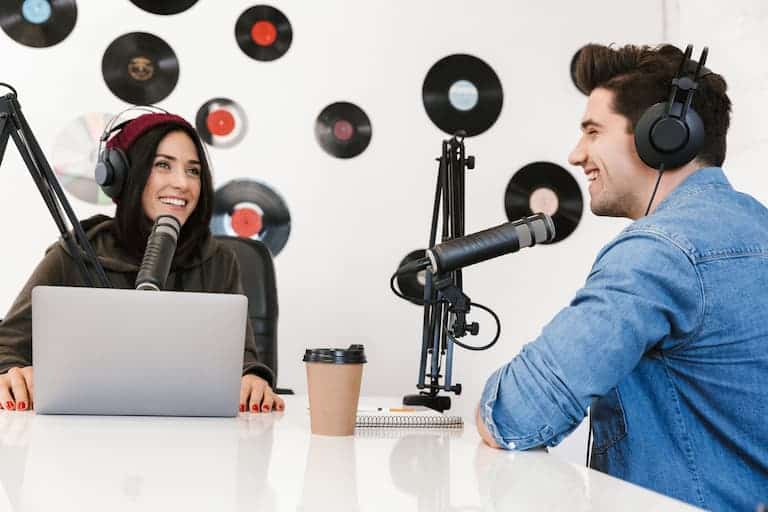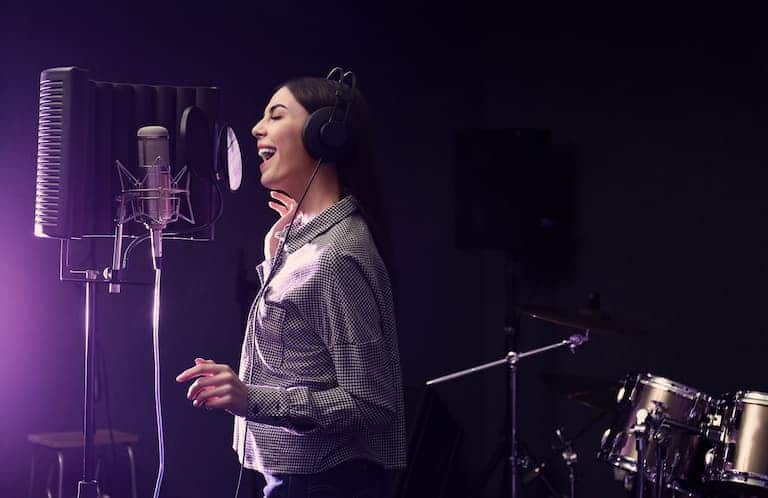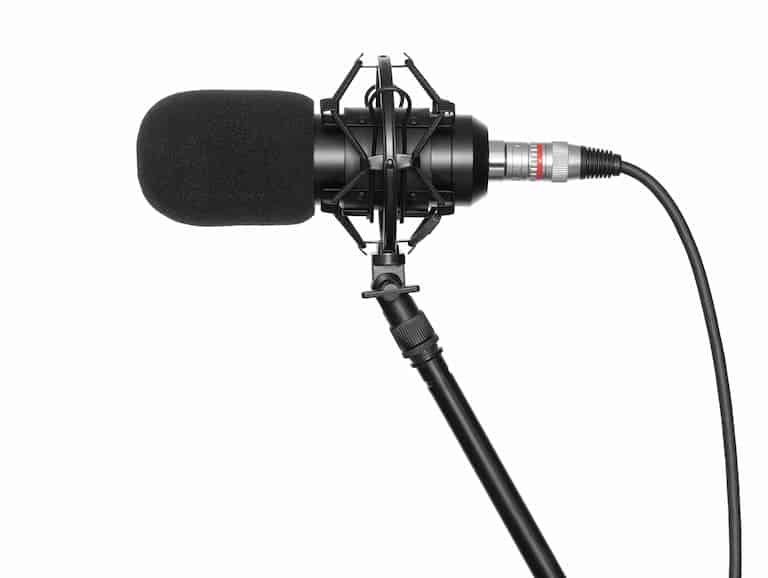Several factors go into recording audio, such as the type of microphone, your position in relation to the mic, and the distance between you and the mic. However, it is often debated whether the loudness of recorded audio affects its quality. So, is it better to record loud or quiet audio?
It is better to record loud audio since it makes the sound more distinct and clear. In contrast, recording quiet audio creates muffled and unclear output. However, one must take measures to prevent distortion or clipping when recording loud.
This article will explain the benefits and drawbacks of recording loud or quiet audio and recommend the ideal volume for recording audio. Read on for more details and tips on getting the best audio quality when recording.

What Are the Ideal dB Levels for Recording My Audio?
Whether you’re recording a video or audio, one of the critical things to consider is the volume level. If it’s too loud, it can distort the sound and make it difficult to hear. On the other hand, it can be hard to hear what’s being said if it’s too quiet. So what’s the ideal dB level for audio?
-12 to -6dB are the ideal dB levels for recording your audio. Recording at these levels will ensure your recording sound is clear and easy to understand. Besides, they will also help prevent distortion and clipping.
However, there may be times when you need to adjust the volume depending on the situation. For example, if you’re recording a video of a live concert, you may want to boost the volume so that the audio is louder than the ambient noise.
On the other hand, if you’re recording an interview, you may want to lower the volume so that the person’s voice is the dominant sound.

Recording Loud Audio: Pros and Cons
Since you already know the ideal volume for recording audio, let’s look at the pros and cons of recording loud audio. After all, just because the volume is turned up doesn’t mean it will automatically be better quality.
Pros
- Loud audio is easier to hear and understand. This is especially true if you’re recording in a noisy environment.
- Loud audio is more distinct. When audio is recorded at a higher volume, the sound waves are more distinct. This makes it easier to identify different sounds, such as footsteps or doors closing.
- Loud audio has less background noise. Since loud audio is more dominant, the background noise is less likely to be heard.
Cons
- Loud audio can distort the sound. If the volume is turned up too high, it can cause the sound to distort. This makes it difficult to understand what’s being said.
- Loud audio can be overwhelming. In some cases, loud audio can be so overwhelming that it’s unpleasant to listen to.
Recording Quiet Audio: Pros and Cons
Although I’ve mentioned, you should record at a higher volume to get better audio quality. But what would happen if you record at a lower volume instead? To understand this, let’s look at the benefits and drawbacks of doing so.
Here are the pros and cons of recording quiet audio:
Pros
- Quiet audio is more intimate. Recording audio at a lower volume creates a more intimate feeling. This can be beneficial if you’re trying to evoke a certain mood or atmosphere.
- Quiet audio is less likely to distort. Since the volume is turned down, there is less of a chance that the sound will distort.
- Quiet audio can be more relaxing. In some cases, quiet audio can be more relaxing than loud audio. That’s because it’s not as overwhelming to listen to.
Cons
- Quiet audio can be difficult to hear. If the volume is too low, it can be hard to hear what’s being said.
- Quiet audio can be muffled. When audio is recorded at a lower volume, the sound waves are more likely to be muffled. This makes it difficult to understand what’s being said.
- Quiet audio can have more background noise. Since quiet audio is less dominant, the background noise is more likely to be heard.
Should the Beat Be Louder Than the Vocals?
The beat shouldn’t be louder than the vocals in general. This is to ensure the words being uttered are clear and understandable. However, if the vocals are too loud, they can start to sound harsh and overdone.
Therefore, it’s important to find the right balance between the two. If you’re unsure how loud the vocals should be, start by recording them at a moderate level and then adjust accordingly.

How Do I Get the Best Sound When Recording?
Many people believe that getting great sound when recording is all about the equipment. While it is true that high-quality gear can make a difference, several other factors also play a role in getting great sound. So, how do you get the best sound when recording?
Here are a few ways to get the best sound when recording:
- Get a quality microphone.
- Use an acoustic treatment.
- Record in a quiet environment.
- Eliminate background noise.
- Experiment with different recording techniques.
I’ll describe each of these below:
Get a Quality Microphone
If you’re serious about getting great recordings, you need to invest in a quality microphone. A good microphone will capture all the detail and subtleties of your performance, giving you a rich, full sound.
It’s also important to make sure that the microphone is positioned correctly. For example, if you’re recording vocals, you’ll want to place the mic close to the mouth but not so close that it picks up breath noise.
You’ll also want to experiment with different microphone techniques, such as using a pop filter or adjusting the mic’s angle. By getting a good quality recording, your music will sound its best.
Use an Acoustic Treatment
Most people don’t think about acoustic treatment when recording, but it’s one of the most important aspects of getting good sound. Acoustic treatment helps reduce reflections and absorb unwanted noise, resulting in a cleaner recording.
There are a variety of acoustic treatments available, so it’s important to choose the right one for your needs. For example, if you’re recording in a small room, absorption panels can help control noise levels. If you’re recording outdoors, windscreens can help reduce wind noise.
By choosing the right acoustic treatment, you can get the best sound possible when recording.
Here’s an excellent primer on how to acoustically treat a room:
Record in a Quiet Environment
It’s important to record in a quiet environment to get the best sound quality for your recording. Background noise can distract from the primary sound source and make it difficult to hear the nuances of the recording.
Additionally, ambient noise can cause clipping and other distortions that can reduce the quality of the recording. For the best results, find a room or space that is acoustically treated or otherwise free from excessive noise.
Eliminate Background Noise
Eliminating background noise is another sure-fire way to get the best sound possible when recording. This noise can come from traffic, air conditioners, and even noisy appliances in your own home.
Here are a few easy ways to eliminate background noise:
- Use a noise gate.
- Move the microphone closer to the sound source.
- Record in a quiet environment.
- Use a windscreen when recording outdoors or in windy locations. I recommend this Mudder Foam Mic Cover
from Amazon.com. It comes with thick, soft, and elastic foam for a snug fit on most microphone sizes. Besides, it protects your microphone from damage, moisture, and dust.
- Microphone cover set: 5 pieces foam mic cover, 2.9 x 2.5 inches, caliber size is 1.4 inches,...
- Thick and soft foam: the ball-type foam microphone windscreen is soft and thick, has good elasticity...
- Widely application: the foam ball windscreen for microphone is suitable for ktv, dance ball,...
Last update on 2025-06-30 / Affiliate links / Images from Amazon Product Advertising API

Experiment With Different Recording Techniques
Finally, don’t be afraid to experiment with different recording techniques. There are various ways to set up your equipment, so it’s important to find the method that works best for you.
For example, if you’re recording a solo instrument, you may want to try using a stereo mic technique. It involves placing two microphones around the instrument, one on each side. Doing this will give you a more natural sound—closer to how the equipment would sound in a live setting.
There are many other recording techniques you can experiment with, so it’s important to find the ones that work best for you and your music. By taking the time to experiment, you can get the best sound possible when recording.
Pro Tip: Besides the above techniques, I recommend investing in a decent digital audio workstation, such as Pro Tools, and a quality laptop. This article provides in-depth information on the best laptops for this DAW.
Conclusion
It’s better to record loud audio as it enables you to get a clean recording with minimal distortion. It’s also important to use an acoustic treatment, record in a quiet environment, and eliminate background noise.
Finally, don’t be afraid to experiment with different recording techniques. By taking the time to find the method that works best for you, you’ll be able to get the best sound possible when recording. Good luck recording!
Sources
- https://gearspace.com/board/audio-student-engineering-production-question-zone/1184107-how-loud-hot-should-i-record.html
- https://www.sciencedirect.com/science/article/abs/pii/S0003682X16304248
- https://www.youtube.com/watch?v=eOhdKdpsetE
Recent Posts
QuickTime is a vital app for many Mac users, and if you’ve recently bought a new microphone, you might wonder how to use it optimally. QuickTime cannot record audio content if it doesn’t have...
Every microphone leaves a unique signature on the quality of its output. If you’re a podcaster trying to melt your way into your audience’s hearts, a muddy, distorted recording won’t cut it....

